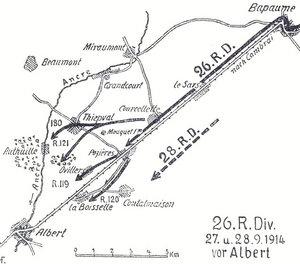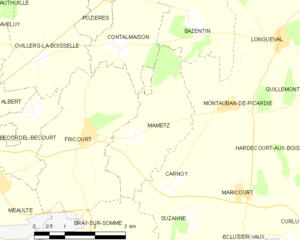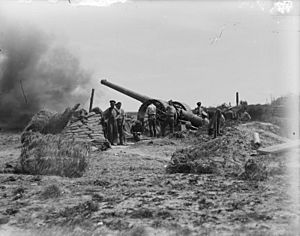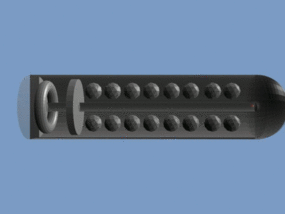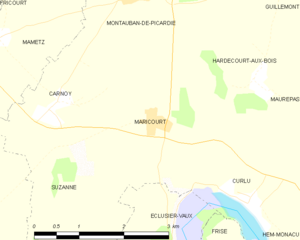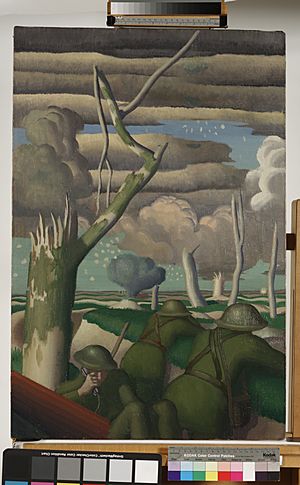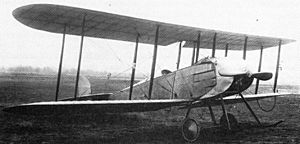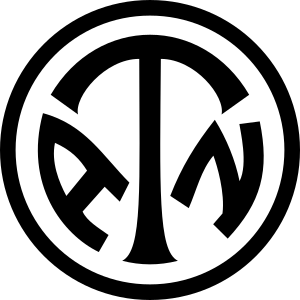Capture of Montauban facts for kids
Quick facts for kids Capture of Montauban |
|||||||
|---|---|---|---|---|---|---|---|
| Part of The Battle of the Somme, First World War | |||||||
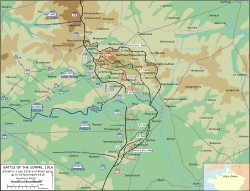 Battle of the Somme 1 July – 18 November 1916 |
|||||||
|
|||||||
| Belligerents | |||||||
| Commanders and leaders | |||||||
| Sir Douglas Haig | Erich von Falkenhayn | ||||||
| Strength | |||||||
| 30th Division 18th (Eastern) Division |
Bavarian Reserve Infantry Regiment 6 Reserve Infantry Regiment 109 |
||||||
| Casualties and losses | |||||||
| 3,011 | 3,957 (incomplete) | ||||||
The Capture of Montauban was a key event on 1 July 1916. This was the very first day of the huge Battle of the Somme during the First World War. British and French armies worked together against the German army. Montauban is a small village (called a commune) in northern France. It was an important target because of its location.
In late 1914, during a period called the Race to the Sea, German troops tried to push west. They wanted to reach the sea and important French cities like Albert and Amiens. French forces stopped them just east of Albert. The fighting then settled into long lines of trenches.
On 1 July 1916, German defenses were strong around Montauban. The British 30th Division attacked this area. They used a special "creeping barrage" of artillery fire. This helped them capture Montauban and the nearby ridge. They caused many losses for the German soldiers. A German counter-attack the next day failed. The British then started operations against nearby woods. German troops did briefly recapture Montauban in March 1918. But the British 18th (Eastern) Division took it back for good in August 1918.
Contents
Why Montauban Was Important
The War in 1914
In September 1914, the war was still moving fast. French forces attacked German troops north of the Somme River. This made the Germans pull back quickly. More German units arrived. The 3rd Bavarian Division advanced along the Somme River. They went through several villages until they were stopped at Maricourt.
Further north, the 4th Bavarian Division pushed through French defenses. They attacked towards Albert, capturing villages like Guillemont and Montauban. Montauban was taken on 28 September. French soldiers had dug in there with their artillery. After this, the fighting slowed down. Both sides began to dig better trenches.
In November 1914, German soldiers were told to improve their defenses. This included Montauban. They made trenches deeper and stronger. They added thick barbed wire fences to stop French patrols. Attacks by French forces in December were stopped. This was even though the Germans had little artillery ammunition. On 21 December, a big French attack on Montauban was defeated. Many French soldiers were captured or killed.
Building Defenses in 1915
In January 1915, the German commander, General Erich von Falkenhayn, ordered better defenses. The trenches had been built quickly at first. Now, they needed to be much stronger. Barbed wire fences were made wider and taller. Instead of one trench line, there were now three. These trenches were about 150–200 yards apart.
Dugouts, which were underground shelters, were made much deeper. They went from 6–9 feet deep to 20–30 feet deep. These dugouts were large enough for 25 men. A second line of strong points was built about 1,000 yards behind the front line. Communication trenches linked everything. This second position was also very strong. It was placed far enough back to be safe from enemy field artillery.
German Defenses in 1916
In February 1916, a third line of defense was started. It was about 3,000 yards behind the second line. This new line was almost finished when the Battle of the Somme began. German artillery was set up to create "barrage sectors." This meant each officer knew which guns covered their part of the front. A telephone system was built to connect the front lines to the artillery.
However, the German defenses on the Somme had problems. The front trenches were on a forward slope. This meant they could be easily seen by enemy observers. The defenses were also very crowded. Most German troops were within 1,000 yards of the front line. This meant they would face the full force of any artillery attack.
Much of the new defense work happened north of Fricourt. The area around Montauban was not as well prepared. For nearly a year, this area was quiet. German soldiers there were known as the "Sleeping Army." In May 1916, the British started showing signs of an attack. German intelligence thought the attack would be further north.
When German Reserve Infantry Regiment 109 moved to Mametz and Montauban in June, they found the defenses poor. Telephone lines were bad. There were not enough supplies or ammunition near the front. By July, more German troops were brought to Montauban.
Getting Ready for Battle
German Preparations
In late May 1916, the German Second Army on the Somme got more soldiers. They had eight divisions in the front line. Three more divisions were kept as reserves. The Germans had about 240 guns. The British had six times more artillery. In early June, British patrols were active. But the front was mostly quiet until 20 June. Then, British heavy guns started firing behind the German lines. This continued until 23 June.
The German front line near Montauban had many trenches. There was also a new reserve line further back. A communication trench, Montauban Alley, was dug. A second strong defense line was about 3,000 yards back. A third line was not yet complete. The ground around Montauban was mostly clay and soil. This was different from the chalky ground further north. This made it harder to build strong defenses.
All available workers were busy repairing the first line during the British shelling. In the 12th Division's area, the second line was shallow. Work on the third line had just started. Strong points like "The Castle" and "Glatz" and "Pommiers" redoubts were made stronger. Montauban village itself was fortified. A trench was dug around its south side.
On the night of 28/29 June, Bavarian Reserve Infantry Regiment 6 (BIR 6) moved to Montauban. The British shelling had reduced the defenders to about thirty men. Many defenses were destroyed. Only three shelters were somewhat safe. The relief of troops was very confusing. BIR 6 took over the area. By the end of 1 July, this regiment had lost 1,809 men. Most of the artillery and ammunition in the valley near Montauban was destroyed. Most of the German machine-guns and soldiers in the front line were wiped out by the bombardment.
British Preparations
In early May 1916, preparations for the attack sped up. Trucks and carts constantly moved supplies behind the British lines. At night, trains delivered ammunition. New trenches were dug. The woods behind the British lines filled with soldiers and guns. The Germans could not stop these preparations. British observation balloons watched all daylight movement. British planes flew over German lines. They took photos, bombed shelters, and attacked German soldiers. When German balloons went up, British planes shot them down.
The British XIII Corps held the front line from Maricourt west to Carnoy. The British front line was at the bottom of a valley. The German front line was higher up the slope. The XIII Corps divisions had to advance up a long, gentle slope. This slope was almost flat on the 30th Division's front.
British Plan
The British XIII Corps planned for the 30th Division to capture Montauban on the first day. East of the village, they would capture Nord Alley and Dublin Trench. This would create a strong defensive side next to the French forces. West of the village, they would reach Montauban Alley. This would give them a good view into Caterpillar Valley.
The first goal was a German reserve line. This was Dublin Trench and Pommiers Trench, about 1,000 yards from the British front line. The attack would then continue to Montauban village and the Montauban–Mametz Ridge. The 30th Division dug a new front line trench. It was about 150–200 yards closer to the German lines. Six communication trenches were also dug.
The infantry attack would be supported by heavy artillery. This artillery would move forward slowly, like a "creeping barrage." The British soldiers were told to stay as close as possible to this moving wall of shells. This would keep the Germans from coming out of their shelters. The 9th (Scottish) Division would be kept in reserve.
Two brigades of the 30th Division would attack first. They would reach the first objective by 8:28 a.m. The third brigade would then advance through them. They would capture Montauban at 9:30 a.m. On the left, the 18th (Eastern) Division would attack next to the 30th Division. When the final goals were reached, engineers would build strong points. Artillery batteries would move forward to support the new front line. A "box-barrage" would be fired around Montauban to stop German counter-attacks.
Artillery Bombardment
On 20 June, British heavy artillery began shelling German communication lines. This went as far back as Bapaume. At dawn on 24 June, a shrapnel barrage started on the German front lines. Shrapnel shells explode in the air and send out many small metal balls. At noon, the firing became more accurate. That evening, light rain turned the German positions into mud. On 25 June, heavy artillery fire destroyed trenches and dugouts. It also set fire to supply dumps in Montauban.
The Germans noticed that the heaviest shelling was at Mametz, Fricourt, and Ovillers. This suggested where the main attacks would be. During the night, German commanders prepared their defenses. They ordered the second line of trenches to be manned. After a quiet night, the shelling increased again on 26 June. Then it suddenly stopped. German soldiers came out, fired red rockets for artillery support, and a German barrage began.
Later that afternoon, huge mortar bombs began to fall. They destroyed shallower dugouts. Super-heavy guns pounded German strong points. Smaller guns destroyed villages near the front line. German troops in villages moved into the open to avoid the shelling. From 27 to 28 June, heavy rain added to the destruction. The shelling varied from steady fire to intense "shell-storms."
At night, British patrols moved into no man's land. They found German trenches lightly held. Captured British raiders said they were checking damage and looking for German survivors. On 27 June, a large explosion was seen in Montauban. Two raids that night found empty German trenches. German officers learned that the attack might start on 29 June.
The German infantry stood ready with reinforcements. But the shelling continued. It rose to "drumfire" intensity many times. Artillery fire focused on small parts of the front. Then lines of shells moved deeper into the German defenses. Gas attacks and infantry probes continued. German sentries often warned their garrisons in time. By 30 June, much of the German surface defenses were gone. Observation posts were ruined. Communication trenches had disappeared.
On 23 June, the headquarters of Reserve Infantry Regiment 23 was destroyed. By 1 July, the shelling had cut the wire around Montauban. It had destroyed German trenches and hit German artillery. The German infantry hid in deep dugouts or shallow support trenches. On the night of 30 June/1 July, the shelling hit rear defenses. Then at dawn, British aircraft "filled the sky." Balloons rose at 6:30 a.m. An intense barrage began all along the German front. It stopped abruptly at 7:30 a.m. The remaining German soldiers came out of their shelters. They set up machine-guns in shell-holes. These were hard to spot.
The Battle for Montauban
July 1, 1916
30th Division's Attack
At 7:22 a.m., a very heavy "hurricane bombardment" began. Eight minutes later, the 89th Brigade attacked. They quickly crossed the 500 yards of no man's land. German soldiers were caught underground. About 300 prisoners were taken. The British wire was well cut.
The battalions moved forward to Casement Trench and Alt Trench. They took prisoners from German's Wood. They waited for the shelling to lift. Then they advanced to Dublin Trench. It was empty at 8:30 a.m. Consolidation began. The trench was badly damaged. Some troops went too far and dug in connecting shell-holes. Three field artillery batteries moved forward.
On the left, the 21st Brigade reached the German front line with few losses. They caught the Germans before they could come out. The leading battalions advanced close to the creeping barrage. They took Alt Trench at 7:45 a.m. The left battalion faced heavy machine-gun fire. This caused many losses. Two clean-up parties were sent to deal with German soldiers who were counter-attacking. Thirty-one prisoners were taken. Many Germans retreated. The way was cleared for the left battalion. They overran a machine-gun nest. The brigade continued its advance. They reached Glatz Redoubt at 8:35 a.m.
The 90th Brigade moved forward at 8:30 a.m. They were bombarded by German artillery. But the muddy ground reduced the effect of the shells. A German machine-gunner caused many losses. But the British troops reached Train Alley fifteen minutes early. They waited for the shelling to lift. A Lewis gun crew silenced the machine-gun nest. A smoke screen covered the advance into Montauban. The trench around Montauban was empty. The infantry entered at 10:05 a.m. They found the village deserted.
British troops moved through the village. As the smoke cleared around 11:00 a.m., they entered Montauban Alley. Another hundred prisoners were taken. Across the valley, hundreds of German troops were seen retreating. British artillery quickly fired on them. Soldiers of the 16th Manchester Regiment attacked German artillery positions. They captured three guns. German artillerymen were machine-gunned and attacked by aircraft. The British began to strengthen their captured positions. A hot meal was brought forward. After 1:45 p.m., German artillery fire caused many losses in the village.
By noon, German headquarters heard that British troops were in Bernafay and Trônes woods. But they had too few soldiers for a counter-attack. Cooks and clerks were sent to occupy the second defense line. At 11:30 a.m., British heavy artillery began shelling La Briqueterie. At 12:30 p.m., a company of the 20th King's Liverpool Regiment advanced. They met no resistance until they reached the far side. The commander of Infantry Regiment 62 and three staff officers were captured. German reinforcements were ordered to attack the Montauban–Mametz ridge during the night. But by midnight, they had only reached the second position.
Air Operations
Planes from 9 Squadron Royal Flying Corps (RFC) flew over the battle. An observer watched the 30th Division advance. Another plane arrived at 10:00 a.m. The crew saw the British soldiers advancing towards Montauban. They saw a German artillery battery setting up in Bernafay Wood. They attacked the gunners with machine-gun fire.
The pilots saw German troops in trenches east of the wood. They attacked them too. As they flew back, they saw the 16th Manchester enter Montauban. They also saw the 18th (Eastern) Division coming up on the left. They flew low over the ridge to wave at the soldiers. By 11:15 a.m., British soldiers were seen along the northern edge of Montauban. A sketch was drawn for headquarters. Balloon observers and plane crews spent the day spotting German artillery. They directed British counter-battery fire.
18th (Eastern) Division's Attack
The 18th (Eastern) Division attacked with all three brigades. They advanced up Carnoy Spur and Mametz Spur. Their first goal was Train Alley and Pommiers Trench. After a pause, they would advance to Montauban Alley. This was about 2,000 yards forward. A third goal was set further forward on the left. This was to capture part of Montauban Spur.
The division's shelling plan was similar to the 30th Division's. Engineers would build strong points. The division would also raid Caterpillar Wood. During May, both sides had dug tunnels and mines. This left a destroyed area in front of Carnoy. The Germans had filled their front trench with wire and obstacles. They then moved to their support line.
A large mine was set to explode at 7:27 a.m. under a German strong point called Kasino Point. Another mine was blown on the far left. The Kasino Point mine was late. The officer in charge hesitated. He saw British troops already advancing. German machine-gunners opened fire, causing many losses. The officer then blew the mine. It sent debris outwards, hitting British soldiers. But it also destroyed German machine-gun nests.
One soldier described the explosion: "A giant fountain, rising from our line of men... then slowly toppled over. Before I could think, I saw huge slabs of earth and chalk thudding down... onto the troops as they advanced." The late explosion surprised the Germans. Their firing decreased. The British swept over the German trenches. This was the most successful mine explosion of 1 July. The three brigades advanced from repaired trenches. They did not use new jumping-off trenches. This was to hide the attack.
The infantry advanced behind a creeping barrage. No man's land was about 200 yards wide. Most German prisoners were from Bavarian Reserve Infantry Regiment 6. This was because of the heavy shelling. On the east side of the crater area, some German soldiers survived. But those on the west side were killed by a flamethrower. Machine-gunners in the crater area fired along no man's land. This caused many losses and delays. The Germans had time to man their support trench. When the creeping barrage moved on, about 300 German troops fired on the attackers. By 8:37 a.m., the right battalion was stuck in the German support line.
Just after 9:00 a.m., the 30th Division's advance threatened the Germans. Some began to retreat towards Montauban. The right battalion of the 55th Brigade moved towards Train Alley. But they could not go further. The left battalion was still short of Breslau Support Trench. The 53rd Brigade in the center advanced. They were helped by the flamethrower and the mine at Kasino Point. The leading battalions easily crossed the front and support lines. The left battalion bypassed Back Trench. They attacked Pommiers Trench. Three German machine-guns had survived. They stopped the advance. But a party of bombers silenced one machine-gun. By 7:50 a.m., Pommiers Trench was captured.
The 54th Brigade on the left advanced fast. They reached Pommiers Trench before the shelling lifted. They had to wait until 7:50 a.m. to occupy it. Bombing parties had taken Black Alley. Preparations began for the 53rd and 54th brigades to advance. On the far right, the division was close to its first goal. On the left, it had reached it. But in the center, most of the 53rd Brigade was held up. The attack on Pommiers Redoubt began at 8:30 a.m. The redoubt had not been heavily shelled. The British infantry advanced against heavy machine-gun fire. The attacks failed in front of the German wire.
An attempt was made to go around the redoubt. British troops got into Maple Trench. They fired along the south side of the redoubt. Most of the attacking battalions got into the redoubt through gaps in the wire. After an hour of hand-to-hand fighting, the Germans were overwhelmed. Maple Trench was also captured. Both sides lost many soldiers. The creeping bombardment had moved far ahead. The advance continued to Beetle Alley. The British bombed their way in at 10:15 a.m. Germans in the trench resisted. An inconclusive bombing fight began.
Further east, the 55th Brigade's advance had just begun. The right flank was short of Train Alley. The center was stuck near the German front trench. At 9:30 a.m., a clearing party overran the Germans at the Carnoy craters. But the defenders of Breslau Support Trench held on.
The reserve battalion of the 55th Brigade went forward. They faced continuous fire. But two companies were protected by the Carnoy Spur. They advanced to the battalion held up below Train Alley. By noon, both battalions reached the Montauban road. British advances on the flanks threatened the Germans. Many survivors began to retreat. By 10:00 a.m., an attack had occupied the area. They took 90 prisoners. About sixty Germans in The Loop surrendered at 10:20 a.m. The last German post held out until 2:00 p.m. Then 152 Germans surrendered. The remaining British troops advanced to the Montauban–Mametz road by 3:00 p.m. They took part of Montauban Alley at 5:15 p.m. after a mortar bombardment. The German survivors retreated into Caterpillar Wood.
Troops who captured Pommiers Redoubt bombed along Pommiers Trench. They reached White Trench by 3:30 p.m. They were joined by troops who had moved along Loop Trench. Both parties then occupied the last part of Montauban Alley. This completed the capture of the 18th (Eastern) Division's second goal. Parties began to move along Caterpillar Trench. They built trench blocks. Advanced parties were set up at the third objective. This overlooked Caterpillar Wood. Field artillery moved forward to Carnoy. Two battalions of the 9th (Scottish) Division helped carry supplies and dig new strong points.
July 2, 1916
The German 12th Reserve Division began to arrive on the afternoon of 1 July. The survivors of the 28th Reserve Division had pulled back. Bernafay and Trônes woods were left undefended. The only German reserve was Bavarian Infantry Regiment 16. The 12th Reserve Division was rushed forward at 9:00 a.m. They were ordered to recapture Montauban and Favières Wood. Overnight, the German commander ordered the Fricourt garrison to withdraw.
Reserve Infantry Regiment 51 (RIR 51) was ordered to advance to Montauban. Other regiments were to recapture Bois Favières. When RIR 51 reached Guillemont, two battalions of Bavarian Infantry Regiment 16 (BIR 16) were to advance towards Montauban Alley. RIR 51 was to recapture Dublin Redoubt, La Briqueterie, and Montauban. The attack was made from 3:00 to 4:00 a.m. The German troops were exhausted. They suffered many losses. The survivors pulled back to a new defensive line.
It was not possible for the Germans to counter-attack again on 2 July. The 10th Bavarian Division had been used up. On the morning of 2 July, the 30th Division artillery tried to set Bernafay Wood on fire. They used 500 thermite shells. Later, patrols found many dead German soldiers in the wood. They took 18 prisoners. The front was quiet, except for German shelling of Montauban.
What Happened Next
Casualties
The 30th Division lost 3,011 soldiers. The 18th (Eastern) Division lost 3,115. German Reserve Infantry Regiment 109 lost 2,147 soldiers. Bavarian Reserve Infantry Regiment 6 lost 1,810. The Bavarian history recorded that BIR 6 lost 3,000 soldiers. Only 500 men survived. Infantry Regiment 62 fought near Montauban and lost 737 soldiers.
Later Operations
July 1916
At 9:00 p.m. on 3 July, the 30th Division occupied Bernafay Wood. They had only six losses. They captured seventeen prisoners, three field guns, and three machine-guns. Patrols found that Trônes Wood was defended. A combined attack on 7 July was postponed. This was because of a German counter-attack on Favières Wood. The British attack began on 8 July at 8:00 a.m. A battalion advanced eastwards. But fire from German machine-guns stopped them.
The French 39th Division attacked at 10:05 a.m. They took the south end of Maltz Horn Trench. A British battalion took the north end. A second attack reached the south-eastern edge of Trônes Wood. The 30th Division attacked again at 3:00 a.m. on 9 July. The 90th Brigade advanced. They rushed Maltz Horn Farm. They then bombed up Maltz Horn Trench. The move into Trônes Wood was almost unopposed. The battalion reached the eastern edge at 8:00 a.m. A German heavy artillery bombardment began at 12:30 p.m. The British withdrew at 3:00 p.m. to Bernafay Wood. A German counter-attack pushed the British back.
A British advance at 6:40 p.m. reached the south end of the wood. Patrols found few Germans. But it was hard to move through the fallen trees. At 4:00 a.m. on 10 July, the British advanced. Some reached the northern tip of the wood. They reported it empty of Germans. More fighting happened at Central Trench in the wood. German troops advanced again from Guillemont. They took several patrols prisoner. By 8:00 a.m. on 10 July, most of the wood was back in German hands. A quiet period followed. The 30th Division was replaced. The remaining British troops were withdrawn. At 2:40 a.m., a huge British bombardment fell on the wood. This was followed by an attack. It killed fifty German soldiers. But it failed to reach its goal.
A second battalion advanced. It entered the wood further north. It took thirty prisoners. It occupied part of the eastern edge. German troops in the wood skirmished with patrols. More German reinforcements arrived. Around noon, more German reinforcements occupied the north end of the wood. At 6:00 p.m., the British artillery fired a barrage. The German attack was canceled. But some German troops reinforced the garrison. Part of a British battalion advanced from the south. It retook the south-eastern edge. On 12 July, a new trench was dug. German attempts to advance into the wood were defeated. The British commander ordered XIII Corps to take the wood "at all costs." The 30th Division was withdrawn. It was replaced by the 18th (Eastern) Division.
1918
Montauban was lost on 25 March 1918. This was during the German spring offensive called Operation Michael. British air reconnaissance saw that the British defense was collapsing. The British air squadrons made a big effort to stop the German advance. The village was captured for the last time on 26 August. This was by the 18th (Eastern) Division. It happened during the Second Battle of Bapaume.
Images for kids


